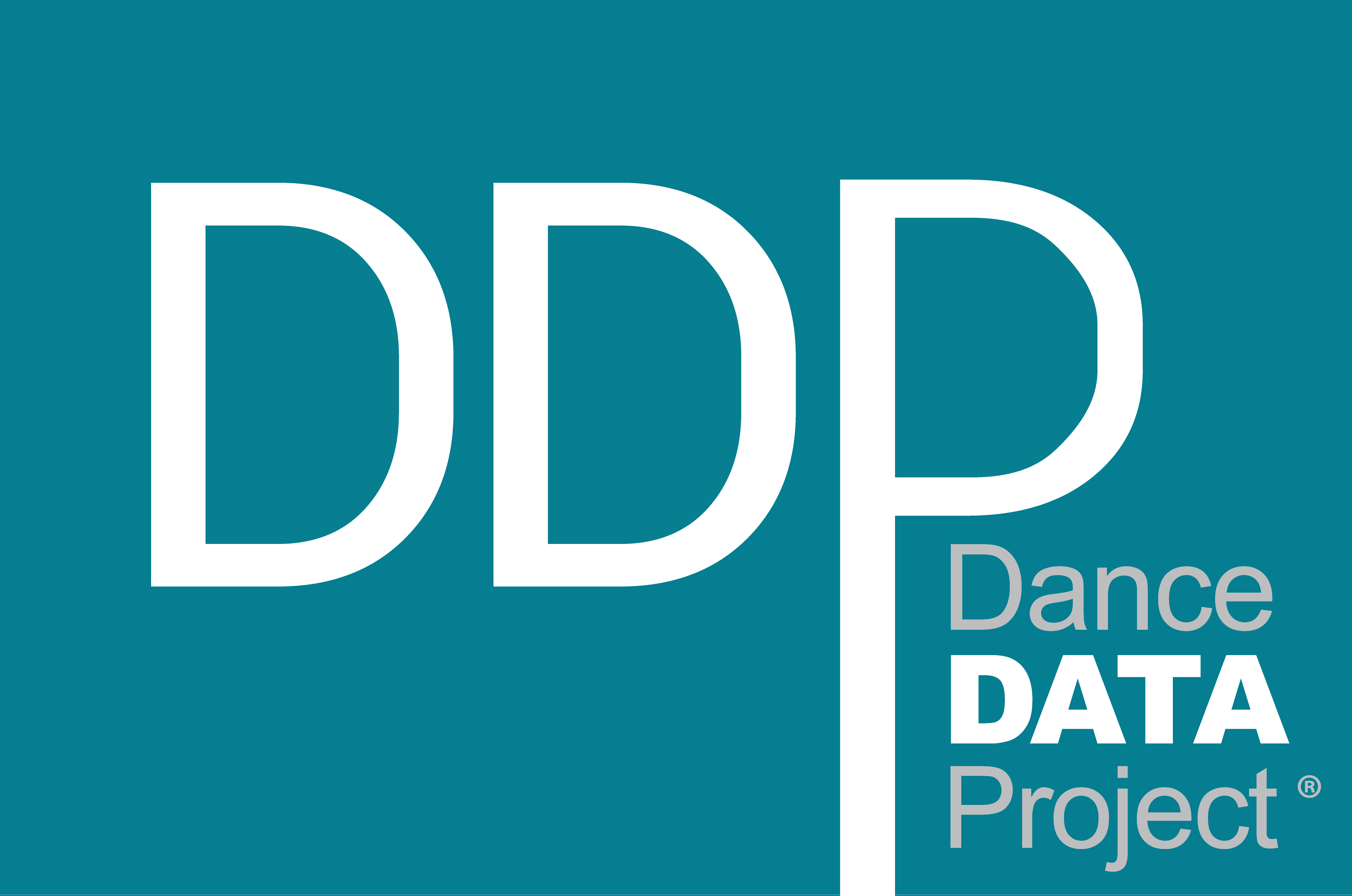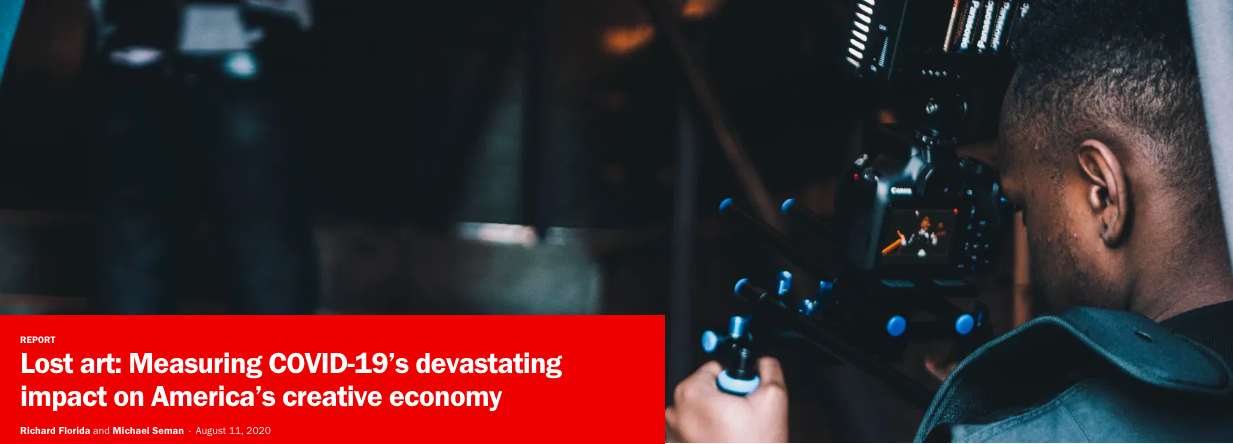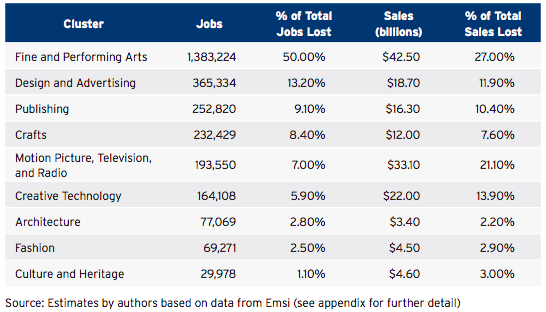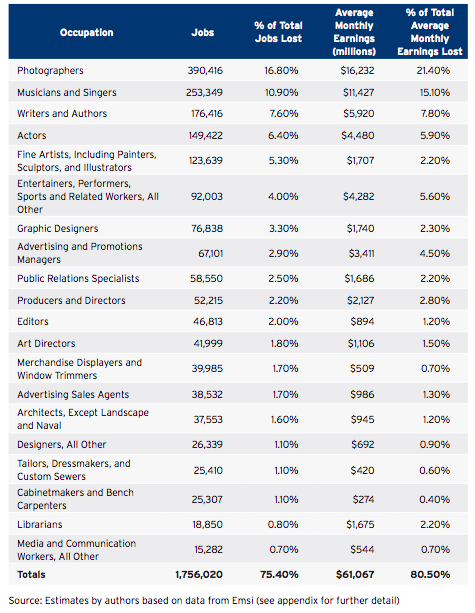Our Top Takeaways From Brookings Institutions’s Lost Art: Measuring COVID-19’s devastating impact on America’s creative economy
The DDP team compiled key figures from Brookings’ Lost Art study on the effect of the COVID-19 pandemic on the American creative economy and the performing arts field, in particular.
Published in August 2020, the report is authored by Richard Florida and Michael Seman. The report focuses on how the pandemic “hits hard at arts, culture, and the creative economy,” and anticipates the overall effects of the crisis on these industries by estimating “losses in sales of goods and services, employment, and earnings for creative industries and creative occupations at the national, state, and metropolitan levels over the period of April 1 through July 31, 2020.”
DDP’s Key Takeaways
Introduction to the Study
The following introduction is featured on page 5 of Brookings’ Lost Art: Measuring COVID-19’s devastating impact on America’s creative economy.
Introduction
The creative economy is comprised of industries and workers in fields such as art, music, film, fashion, and design, which are central to our culture and quality of life. It is also a key factor in talent attraction, and along with science and technology, acts as a key contributor to the knowledge economy.
The creative economy consists of two key components and can be looked at in two ways. The creative industries include firms and establishments that produce goods and services relating to arts and culture. These industries— which span arts, culture, and design—employ 8.8 million workers and generate over $1.7 trillion in sales annually, which represents 4% of annual sales of goods and services in the United States.
Creative occupations are the second component of the creative economy. These occupations reflect workers who are employed in creative occupations regardless of industry type. Creative occupations employ 7.6 million people nationwide, paying almost $42 billion in monthly average earnings. These figures represent 4% of total employment and 15% of monthly average earnings nationwide.
The COVID-19 crisis has hit the U.S. economy hard, with an estimated 4.8% reduction in GDP that has resulted in a current-dollar loss of $191.2 billion in the first quarter of 2020. Over 21 million jobs in March and April were lost, translating to a 14.7% unemployment rate. Although the entertainment, leisure, hospitality, and retail industries suffered the biggest initial losses in employment, the COVID-19 crisis has left no industry untouched. It is the biggest shock to the U.S. economy since the Great Depression.
This is not the first time a global pandemic has impacted the creative economy. The Spanish flu pandemic of 1918 disrupted the production and consumption of various art forms. From widespread cancellations of public events to the deaths of artists, the effects of the pandemic impacted plays, concerts, operas, and paintings. On a far greater scale, the Black Death raged through Europe during the early days of the Renaissance in the 14th century, challenging artists and patrons alike. Still, arts, culture, and creativity persevered through these and other great crises.
To get at the economic impacts of the COVID-19 crisis on the creative economy, we constructed a model to estimate the initial effects the crisis will have on creative-economy employment and revenues in the United States. This model uses employment and revenue data provided by Emsi, according to industry and occupation definitions by the North American Industry Classification System (NAICS) and the Standard Occupational Classification (SOC) system. Our analysis covers the period of April 1 to July 31, 2020. (The Appendix provides fuller detail on our methodology and data.)
The following section of the report looks at COVID-19’s overall impact on creative industries and occupations across the entire United States. We then turn to the impact of the crisis at different levels of geography. First, we look at the crisis’ impact on the four broadly defined U.S. census regions (the Northeast, South, Midwest, and West) and examine the effects in each. We then turn to the impact of the crisis on the 50 states. After that, we look at the impact on the 53 largest metropolitan areas. We conclude by summarizing our key findings and discussing their implications for polices that can help mitigate the effects of the crisis on the creative economy and further support those industries going forward.
Facts & figures
Need a visual? The following figures break down some more key findings from the study. We also encourage you to view more graphic representations of Brookings Institution’s research in the full report, linked at the end of this post.
The following figure shows estimated losses by clusters of creative industries from April to July 2020. Source: Lost Art: Measuring COVID-19’s devastating impact on America’s creative economy
In the figure below, cumulative losses by the top 20 creative occupations are broken down into estimated job losses and monthly earnings lost from April to July 2020. Source: Lost Art: Measuring COVID-19’s devastating impact on America’s creative economy







